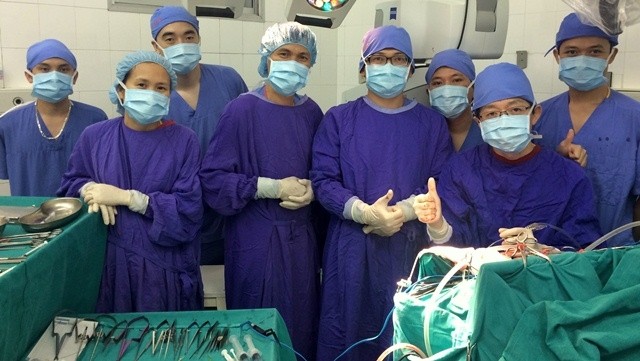Assoc. Prof., Dr. Dong Van He, Director of the hospital’s Centre for Neurosurgery, said that the patient (8 years old) was hospitalised on June 3 with a massive aneurysm of 10x12 cm in size. This is a rare case in medicine as normally a big internal carotid artery aneurysm is approximately > 1.5cm, while any larger than 2.5cm is considered giant.
According to Doctor He, a carotid artery aneurysm is a type of vascular malformation that is caused by the deformity of artery walls; the aneurysm is formed by the pressure of the blood flow. This is a serious disease but the symptoms are often very ambiguous with a prevalence of just 1-2% in the community.
This condition causes bleeding and depending on the degree of bleeding, it can cause subarachnoid haemorrhage, hematuria in the brain’s parenchyma, intraventricular haemorrhage or even subdural haemorrhage and may directly threaten the lives of patients. Furthermore, the aneurysm can also compress the surrounding nerve structures.
For the child patient, the aneurysm caused direct compression on the nerves of the basilar skull’s vessels which led to symptoms due to the increased skull pressure by the giant aneurysm.
 |
The child patient’s giant internal carotid artery aneurysm.
In particular, the aneurysm squeezed directly into the optic nerves causing the patient to lose sight completely. The patient had lost sight in the left eye for many years and within a month the right eye’s sight had decreased significantly.
In addition to the giant internal carotid artery aneurysm, the patient also suffered from multiple aneurysms in the body, such as in the lower right arteria subciavia, left renal artery and right arm artery. Without timely intervention, there would have been a high risk of fatality.
The hospital invited Prof. Katsumi Takizawa, Director at Department of Neurosurgery from Japanese Asahikawa Red Cross Hospital, a leading expert in neurosurgery, to join the surgery in Hanoi.
On June 8, the operative team consisting of six doctors led by Dr. He and Prof. Katsumi Takizawa performed the surgery, which lasted for more than 12 hours.
After the surgery, Dr. He said that the patient is still actively being resuscitated at the hospital with initial good results. The patient will be monitored until reaching a stable condition and then can be discharged.
















